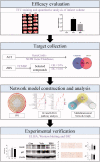Network pharmacology approach to investigate the multitarget mechanisms of Zhishi Rhubarb Soup on acute cerebral infarction
- PMID: 35938510
- PMCID: PMC9364736
- DOI: 10.1080/13880209.2022.2103718
Network pharmacology approach to investigate the multitarget mechanisms of Zhishi Rhubarb Soup on acute cerebral infarction
Abstract
Context: Zhishi Rhubarb Soup (ZRS) is a traditional Chinese medicine formula used in the clinic to treat acute cerebral infarction (ACI) for many years. However, the exact mechanism of the treatment remains unclear.
Objective: This study elucidates the multitarget mechanisms underlying the effects of ZRS on ACI using network pharmacology analysis and verify its effect by performing animal experiments.
Materials and methods: Using the network pharmacology approach, the multiple components, critical targets and potential mechanisms of ZRS against ACI were investigated. Six herbal names of ZRS and 'acute cerebral infarction' were used as keywords to search the relevant databases. In addition, we established the MCAO model to verify the results of network pharmacology enrichment analysis. ZRS (10 g crude drug/kg) was gavaged once per day for 7 consecutive days beginning 3 h after model establishment. After ZRS treatment, TTC staining, Western blot analysis, IHC and ELISA were conducted to further explore the mechanism of ZRS intervention in ACI.
Results: The network pharmacology approach identified 69 key targets, 10 core genes and 169 signalling pathways involved in the treatment of ACI with ZRS. In vivo experiment showed that ZRS treatment significantly reduced cerebral infarction volume (42.76%). It also reduced the expression level of AGE, RAGE and P65; and inhibited the expression of inflammatory MMP-9 and IFN-γ.
Conclusions: This study demonstrated that ZRS improved cerebral ischaemic injury by inhibiting neuroinflammation partly via the AGE-RAGE signalling pathway. It provides a theoretical basis for the clinical application of ZRS in the treatment of ACI.
Keywords: Ischaemic stroke; mechanism of action; signalling pathways; traditional Chinese medicine formula.
Conflict of interest statement
The authors report no declarations of interest.
Figures







References
-
- Anderson CS, Huang Y, Lindley RI, Chen X, Arima H, Chen G, Li Q, Billot L, Delcourt C, Bath PM, et al. . 2019. Intensive blood pressure reduction with intravenous thrombolysis therapy for acute ischaemic stroke (ENCHANTED): an international, randomised, open-label, blinded-endpoint, phase 3 trial. Lancet. 393(10174):877–888. - PubMed
-
- Chen X, Chen H, He Y, Fu S, Liu H, Wang Q, Shen J.. 2020. Proteomics-guided study on Buyang Huanwu decoction for its neuroprotective and neurogenic mechanisms for transient ischemic stroke: involvements of EGFR/PI3K/Akt/Bad/14-3-3 and Jak2/Stat3/cyclin D1 signaling cascades. Mol Neurobiol. 57(10):4305–4321. - PubMed
-
- Chen H, He Y, Chen S, Qi S, Shen J.. 2020. Therapeutic targets of oxidative/nitrosative stress and neuroinflammation in ischemic stroke: applications for natural product efficacy with omics and systemic biology. Pharmacol Res. 158:104877. - PubMed
MeSH terms
Substances
LinkOut - more resources
Full Text Sources
Medical
Miscellaneous
